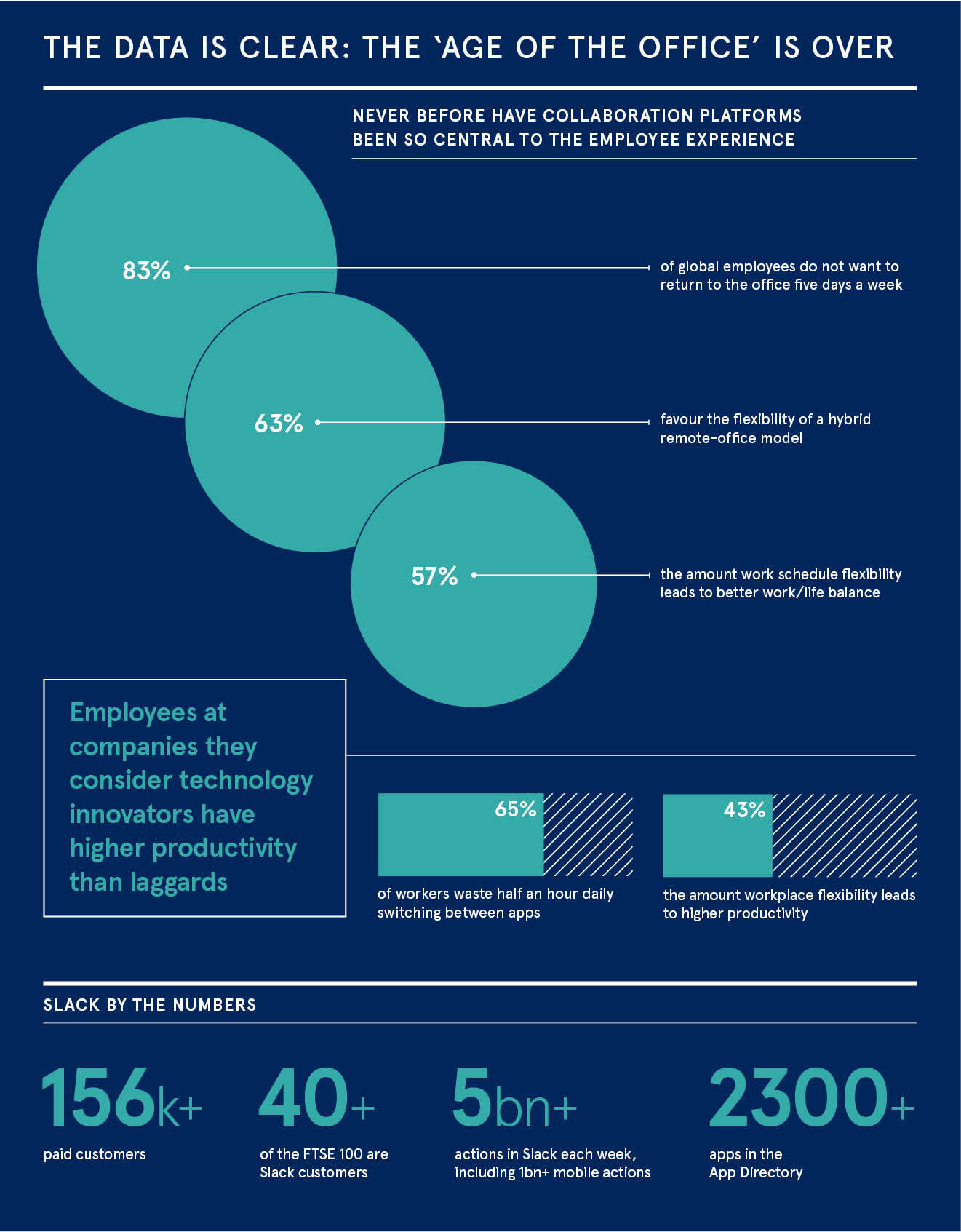At the start of the pandemic, with all office staff suddenly needing to work from home, chief information officers (CIOs) had to quickly transform core technology and security. A year on, having witnessed strong growth in output and innovation opportunities, CIOs must now redefine the experience for employees, customers and partners, enabling effective collaboration, new revenue streams and profitable growth.
A more flexible, hybrid work world is emerging, where employees increasingly choose their preferred mix of home and office time. While traditional workspaces are expected to remain part of the business picture, “in many cases, the old nine-to-five office culture and mentality is over”, says Johann Butting, vice president for Europe, Middle East and Africa at Slack, the messaging app for business that organises conversations into channels for team efficiency and synchronisation.
He adds: “People like the flexibility they’ve been given in the past 12 months to manage work around childcare and other priorities in the home. Presenteeism is slowly eroding in favour of flexible and efficient work.”
CIOs empowering hybrid work
Employees have expressed strong support for hybrid work and fewer than 12 per cent of knowledge workers want to return full-time to the office post-pandemic. This is according to research by the Future Forum, a consortium that includes Slack, Boston Consulting Group, Stanford University and Fortune magazine.
On the other hand, a complete focus on fully remote-based work is not that popular and nearly three quarters of people want the easier sense of belonging from at least some office interaction.
Establishment of hybrid work is only possible with the C-suite’s enablement of a nuanced approach to culture, technology and operations. CIOs will need to strike a careful balance of technology and its influence on work styles, unlocking effective hybrid work for existing staff and helping attract future talent.

In terms of systems, leaders will be tasked with ensuring more advanced collaboration technology is in place, particularly given the growing email burden for staff. “With remote work, organisations are finding the traditional email inbox has become an information vacuum, getting ever more complex and excluding important stakeholders,” Butting notes.
Simultaneously, CIOs face the pressing need to shape new technology-based cultures that enable people to use systems well. They will focus on how to protect efficiency: some 64 per cent of workers who feel aligned to and motivated by core company values are still frustrated operationally, wasting half an hour daily switching between apps, according to research by Slack. CIOs must consider how to cut the time lost searching for information or trying to understand new platforms, providing the resources and training necessary.
With the right culture and technology in place, technology leaders can drive out manual processes, automate efficiencies and design effective workflows. “The role of the CIO will increasingly be about helping to level up the workforce from a tech perspective and enable it to be truly efficient and supported,” says Butting.
CIOs will need to listen carefully to the changing needs of employees, who want to be happy in the job and able to achieve team results no matter where they work
As part of the focus on culture and tech, a major effort must be made around employee wellbeing. Remote staff are commonly impacted by solitude, while being expected to be logged on for longer hours. “There is no doubt employee wellbeing must be front of mind in these technology-based changes. There must be policies around how collaboration platforms are used for work as well as to communicate with individuals to help support their wellbeing,” he says.
Asynchronous work, in which people across time zones can easily collaborate and share experiences, will also become crucial. “CIOs will need to listen carefully to the changing needs of employees, who want to be happy in the job and able to achieve team results no matter where they work,” says Butting.
In practice
Technology heads at more than 750,000 businesses have already introduced Slack as their “digital headquarters” across offices and homes, increasing productivity and growth. Slack is enabling them to build a culture of hybrid, asynchronous work, leaving behind the nine-to-five, and replacing complex email thread burdens and siloed productivity with live chat, borderless workflow creation and seamless automation. As a result, they are making projects more efficient, removing manual and complex processes, improving satisfaction and productivity, and strengthening documentation.
Companies are also using the powerful Slack Connect feature to communicate consistently with external partners and clients. As they reimagine customer journeys and related processes, and find new revenue streams for post-pandemic times, the walls between sales, marketing and customer service are dissolving. Across markets, businesses are relying on specialist partners to deliver memorable and engaging experiences to secure sales and deliver long-term growth.
HM Revenue & Customs recently used Slack to help design, implement and deliver a number of digital services that allowed more than 12 million affected businesses and citizens to apply for financial support during the pandemic. Communicating in Slack channels, more than 2,000 people across 60 teams, mostly working from home, were able to collaborate at record speed. This helped HMRC deliver a project that would usually take several months in less than five weeks.
Meanwhile, Gymshark, the fitness community and apparel brand with more than 16 million social media followers, uses Slack to replace siloed email inboxes with collaborative, internal communications, hosting 95 per cent of the company’s communications. And the telecoms giant Vodafone has integrated the tool into everyday operations for technology and architecture teams, moving from localised messaging and email threads, to intuitive workflow and knowledge sharing.
The hybrid work world is here to stay. CIOs have a clear responsibility to empower employees with the collaboration tools and related work culture that enable productive, positive and efficient work in all environments.
Learn how to transform your organisation into a more connected, inclusive and flexible workplace of the future by registering for Slack Frontiers, taking place virtually this October
Promoted by Slack

